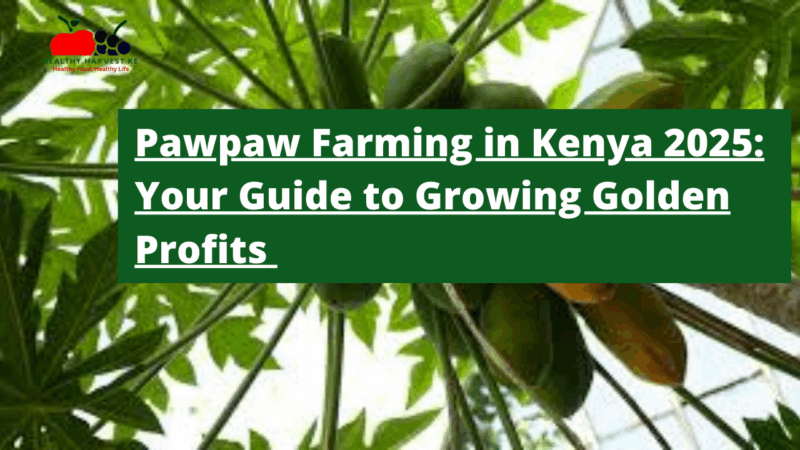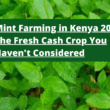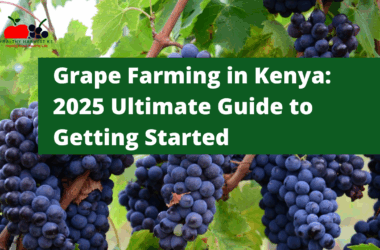Why Pawpaw Farming Might Be Your Next Smart Move
Looking for a farming venture that pays back fast and keeps giving? Pawpaw farming in Kenya has quietly transformed from backyard gardening to serious business. With harvest possible in just 8-12 months and potential profits of Ksh 726,500 from a single acre in the first year alone, it’s no wonder more Kenyans are getting excited about this tropical fruit.
Unlike other fruit trees that take years to mature, pawpaw (Carica papaya) gives you quick returns while requiring relatively modest investment. As Kenya’s fourth most important fruit crop after oranges, mangoes, and bananas, pawpaw has serious market potential both locally and internationally.
I’ve spent the last few months researching sustainable farming options, and pawpaw consistently stands out. Let’s break down why it might be your next smart move.
The Real Deal About Pawpaw in Kenya
Pawpaw trees are short-lived perennials with an economic lifespan of about 4 years, though they can live up to 10 years biologically. Commercial pawpaw production really took off about three years ago, showing just how quickly the industry is evolving.
What makes these fruits special? They’re packed with vitamins A and C, loaded with antioxidants like lycopene, and provide good dietary fiber. This nutritional profile has boosted demand both in Kenyan markets and abroad.
The best part? With proper management, pawpaw trees produce year-round, creating a steady income stream rather than the feast-or-famine cycle many seasonal crops bring.
Choosing Your Pawpaw Variety: What Works in Kenya
Not all pawpaws are created equal. Your variety choice affects everything from taste and appearance to market acceptance and price. Here’s the inside track on Kenya’s top performers:
Solo Sunrise
This variety produces small, round, sweet fruits with consistent size and shape. Being hermaphroditic (self-pollinating), it doesn’t require separate male and female plants. Both local buyers and exporters love its reliability.
Calina (IPB9)
With smooth pear-shaped fruits weighing 400-650g and gorgeous reddish-orange flesh, Calina is a high-yielder that catches the eye at market stalls.
Premium Varieties Worth Considering
Vega F1: Medium-sized fruits with striking red flesh that’s firm and sweet. Weighing 1-1.2kg, they’re perfect for fresh fruit markets where looks matter.
Red Royale F1: These improved beauties weigh 1.7-2.3kg with exceptional sweetness and attractive red color – definitely commanding premium prices.
Sinta F1: Expect fruits around 2kg with deep yellow, firm, sweet flesh. Female plants produce round fruits while hermaphrodites yield oblong ones.
Golden Caliman: If you’re eyeing export markets, this variety stands out. Its shipping qualities and shelf life make it ideal for international sales.
Mountain Papaya: These smaller fruits work well for processing into jams and preserves rather than fresh consumption – perfect if you’re planning value-added products.
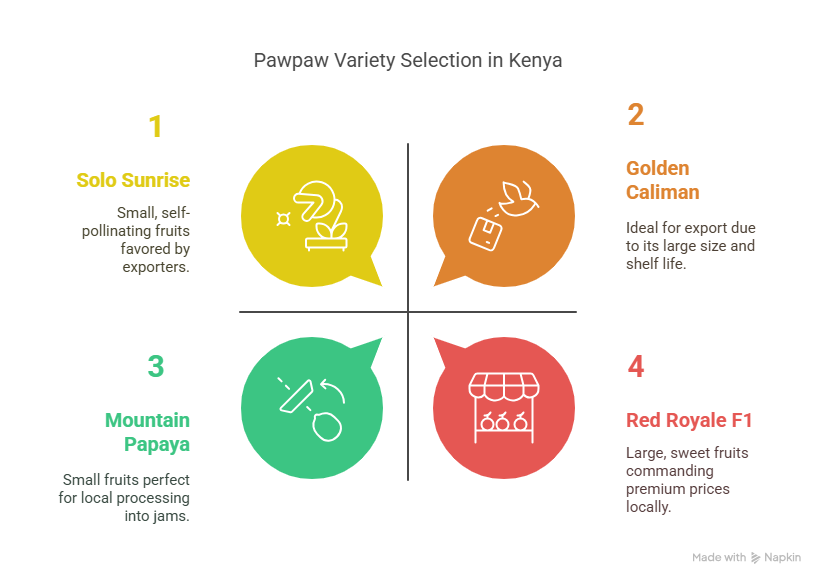
Getting Started: The Right Conditions for Success
Climate & Soil Sweet Spots
Pawpaw thrives in warm to hot climates below 2,100 meters above sea level. You’re looking for temperatures between 25-28°C, with Kenya’s peak production typically falling between August and October.
You’ll need about 1,000mm of rainfall annually, spread throughout the year. During dry spells, irrigation becomes essential to maintain growth and fruit development.
While pawpaw can grow in various soils, it performs best in deep, well-drained soils that hold moisture without becoming waterlogged. Though roots can go 2 meters deep, most nutrient uptake happens in the top 50cm of soil – so focus your soil improvement efforts there.
Understanding Pawpaw Trees: The Birds and Bees
Here’s something interesting: pawpaw trees come in three sexual types – male, female, and hermaphrodite.
- Male trees produce only pollen and never bear fruit
- Female trees need pollination to produce edible fruits
- Hermaphrodite trees can self-pollinate (making them ideal for commercial growing)
One heads-up: pawpaw trees have shallow root systems and tall, slender trunks, making them prone to toppling in strong winds. Consider windbreaks or support systems if your location gets breezy.
Step-by-Step: Growing Your Pawpaw Empire
Seeds vs. Tissue Culture: Which Way to Go?
Most Kenyan farmers start with seeds – it’s cheaper and works well. Select seeds from controlled pollination, dry them, and you might want to remove the outer seed coat layer to boost germination.
Pro tip: Soak seeds in growth stimulants before planting for more uniform germination. Plant 4-5 seeds about 1cm deep and 15cm apart, then cover lightly with soil. You’ll see sprouts in 2-3 weeks.
The downside? Seed-grown plants produce fruits with varied shapes, sizes, taste, and color. For commercial operations where consistency matters, consider tissue culture seedlings instead.
Tissue culture gives you genetically identical plants with traits like disease resistance and high yields. It costs more but guarantees uniformity – something worth considering if you’re targeting premium markets.
Planting Your Future Fruits
- Dig planting holes 60cm wide and 60cm deep
- Space them either 3m x 3m (traditional) or 2m x 2m (intensive)
- With 2m x 2m spacing, you’ll fit about 1,100 plants per acre
- Mix 18kg of well-decomposed manure with 60 grams of double superphosphate fertilizer and your topsoil
- Plant four seedlings per hole initially
- After flowering, when you can identify plant sex, thin to one plant per hole (keeping hermaphrodite or female plants)
- Firm soil around seedlings and apply 40 grams of CAN fertilizer as initial nutrients
Keeping Your Pawpaw Trees Happy & Productive
Feeding Your Future Fortune
Pawpaw trees are hungry feeders. Apply 200g of CAN (Calcium Ammonium Nitrate) or ASN (Ammonium Sulphate Nitrate) fertilizer to each plant once annually when the rains begin.
For organic production, well-decomposed manure works wonders – just keep it away from direct contact with the stem to prevent rot.
Water: The Lifeblood of Your Pawpaw Business
While pawpaw can handle short dry periods, consistent moisture is critical for proper growth and fruit development. You’ll need irrigation during extended dry spells.
Drip irrigation works particularly well, delivering water directly to roots while keeping leaves dry (which helps prevent disease). Budget about Ksh 20,000 per acre for a basic irrigation setup.
The Weed Battle
Young pawpaw plants hate competition. Regular weeding is essential, especially during establishment when they’re fighting weeds for nutrients, water, and light.
Mulching around plants tackles two problems at once – suppressing weeds while conserving soil moisture. As a bonus, the mulch breaks down to add organic matter to your soil.
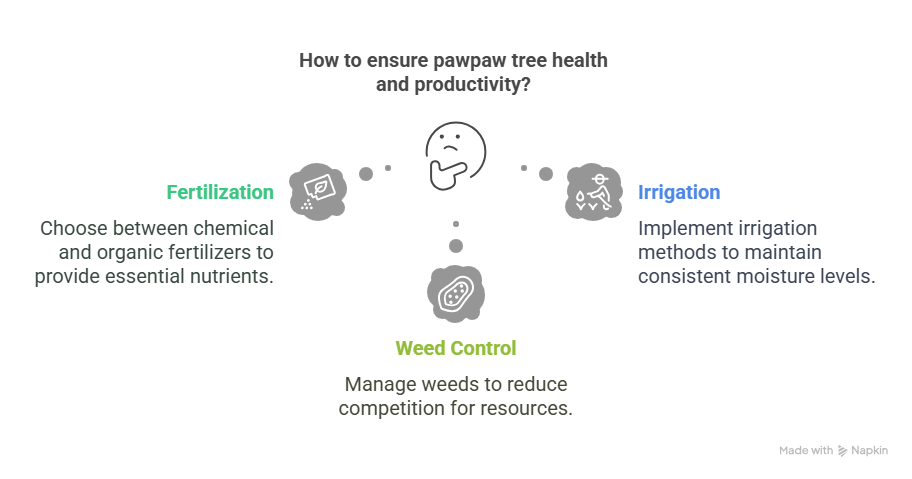
The Biggest Threat to Your Pawpaw Business
Meet the Papaya Mealybug
Since 2016, the papaya mealybug (Paracoccus marginatus) has become pawpaw farming’s public enemy #1 in Kenya. This tiny sap-sucker from Central America has invaded over half of Kenya’s pawpaw-growing counties in just four years.
The damage is serious – crop losses ranging from 53-100% and economic losses around Ksh 354,000 per hectare annually. Some small farmers have simply given up on pawpaw because of this pest.
The Science-Based Solution
Here’s some good news: researchers at the Centre for Agriculture and Bioscience International (CABI) have introduced a biological control program using parasitic wasps – natural predators of the papaya mealybug. These tiny wasps attack mealybugs by laying eggs on them until they die, without affecting the fruit.
Between July 2022 and July 2023, these wasps were released in Kilifi, Kwale, and Mombasa counties with promising early results. This approach outperforms chemical controls, which farmers report were both ineffective and expensive, eating up to 80% of production budgets.
Show Me the Money: What’s the Return?
Investment Breakdown for One Acre
Starting a pawpaw farm requires initial capital. Here’s what you’re looking at per acre:
- Land clearing (ploughing): Ksh 4,500
- Holes preparation (digging and manure application): Ksh 33,000
- Manure: Ksh 20,000
- Seedlings: Ksh 66,000
- Crop protection (pesticides and fungicides): Ksh 10,000
- Irrigation: Ksh 20,000
- Labor (for general orchard maintenance): Ksh 20,000
Total initial investment: Approximately Ksh 173,500 per acre
The Profit Picture
Now for the exciting part. With conservative estimates of 30 tons yield per acre in the first year and a farm gate price of Ksh 30 per kilogram, you’re looking at:
- Gross annual income: Ksh 900,000
- First-year profit after subtracting initial investment: Approximately Ksh 726,500
Similar production and revenue continue in the second year, with declining returns afterward. Most farmers replant after 4 years when productivity naturally decreases.
That’s a return on investment exceeding 400% in the first year alone – making pawpaw one of Kenya’s most profitable fruit crops.
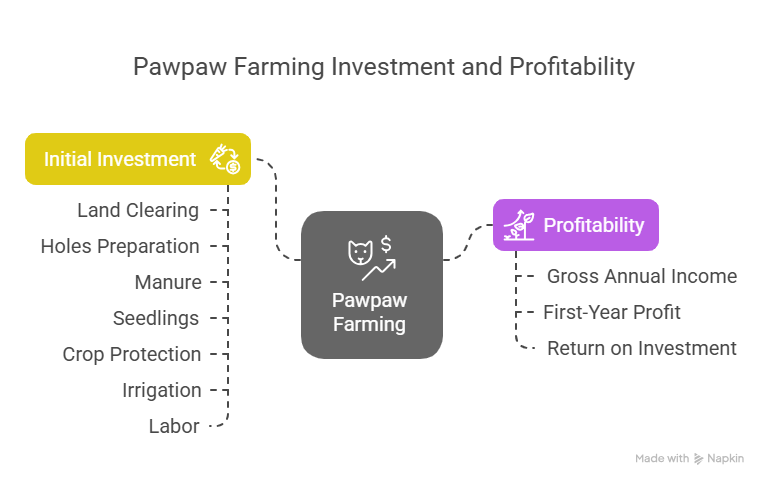
Beyond Fresh Fruit: Multiple Revenue Streams
Pawpaw offers more than just one way to make money:
- Fresh fruit markets: Sell directly to local consumers or export premium quality fruits
- Processing industry: Transform fruits into jams, juices, dried products, and preserves
- Export markets: Especially for varieties like Golden Caliman that meet international standards
- Medicinal products: Derived from pawpaw leaves and seeds, which contain valuable compounds
Value-added processing significantly increases profit margins and extends your marketing beyond harvest season, reducing dependence on fresh fruit sales and protecting against price fluctuations.
The Export Advantage
Kenya’s location and climate give it a competitive edge in supplying European markets, particularly during their off-seasons. As global demand for tropical fruits grows and more people recognize pawpaw’s health benefits, export opportunities expand for Kenyan farmers who meet international quality and safety standards.
Challenges You’ll Face & How to Beat Them
The Mealybug Menace
As mentioned earlier, the papaya mealybug remains the biggest current threat. While biological control shows promise, you’ll need integrated pest management approaches to address this and other potential pests.
Keeping Production Going
Remember, pawpaw plants are economically productive for about 4 years. Plan for staggered planting to ensure continuous production while parts of your orchard undergo renewal.
Climate Concerns
Pawpaw’s vulnerability to wind damage and specific climate needs make it susceptible to climate change impacts. Consider:
- Diversifying production areas
- Selecting more resilient varieties
- Implementing protective measures like windbreaks
Your Pawpaw Business Plan: Getting Started Right
Creating a solid business plan is crucial for pawpaw farming success. Include detailed sections on:
- Market analysis (who will buy your pawpaw?)
- Production plan (variety selection, planting schedule)
- Financial projections (start-up costs, operational expenses, revenue forecasts)
- Marketing strategy (direct sales, wholesalers, processors, exporters)
- Risk management (pest control, climate adaptation, market fluctuations)
Ready to Grow Your Way to Profits?
Pawpaw farming in Kenya offers substantial opportunities with impressive profitability potential, diverse market channels, and relatively quick returns on investment. The transformation from backyard growing to commercial production continues gaining momentum, supported by research advances in pest management and variety improvement.
With proper planning, management, and marketing strategies, pawpaw farming can significantly boost your income while contributing to Kenya’s agricultural export sector. As awareness of pawpaw’s nutritional benefits grows both locally and internationally, the market outlook remains highly favorable.
What farming questions do you have? Drop them in the comments below, and let’s grow together!




